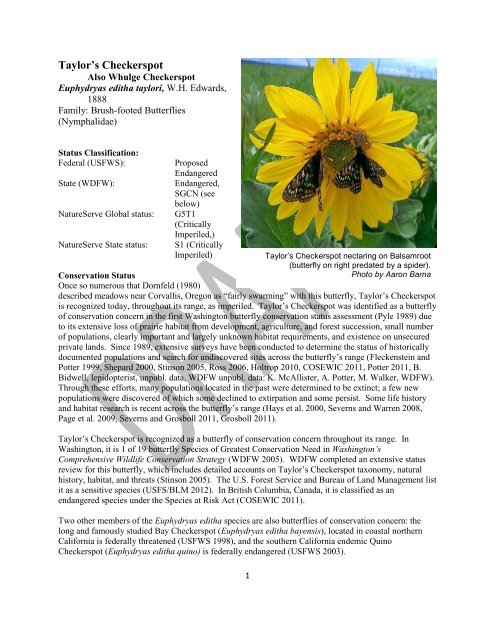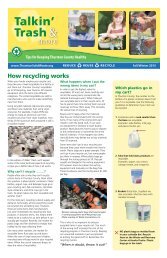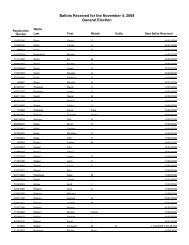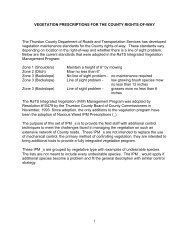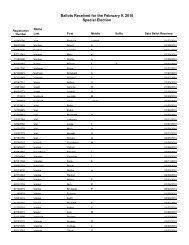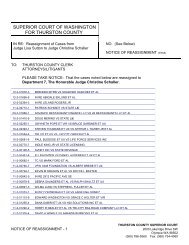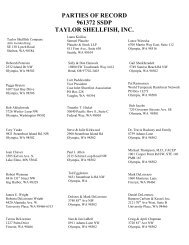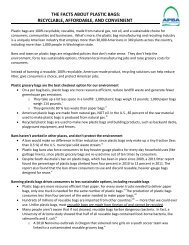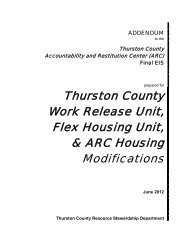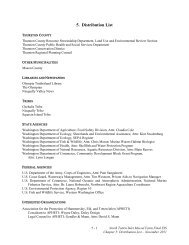Taylor's Checkerspot Butterfly - Thurston County
Taylor's Checkerspot Butterfly - Thurston County
Taylor's Checkerspot Butterfly - Thurston County
Create successful ePaper yourself
Turn your PDF publications into a flip-book with our unique Google optimized e-Paper software.
Taylor’s <strong>Checkerspot</strong><br />
Also Whulge <strong>Checkerspot</strong><br />
Euphydryas editha taylori, W.H. Edwards,<br />
1888<br />
Family: Brush-footed Butterflies<br />
(Nymphalidae)<br />
Status Classification:<br />
Federal (USFWS):<br />
State (WDFW):<br />
NatureServe Global status:<br />
NatureServe State status:<br />
Proposed<br />
Endangered<br />
Endangered,<br />
SGCN (see<br />
below)<br />
G5T1<br />
(Critically<br />
Imperiled,)<br />
S1 (Critically<br />
Imperiled)<br />
Conservation Status<br />
Once so numerous that Dornfeld (1980)<br />
described meadows near Corvallis, Oregon as “fairly swarming” with this butterfly, Taylor’s <strong>Checkerspot</strong><br />
is recognized today, throughout its range, as imperiled. Taylor’s <strong>Checkerspot</strong> was identified as a butterfly<br />
of conservation concern in the first Washington butterfly conservation status assessment (Pyle 1989) due<br />
to its extensive loss of prairie habitat from development, agriculture, and forest succession, small number<br />
of populations, clearly important and largely unknown habitat requirements, and existence on unsecured<br />
private lands. Since 1989, extensive surveys have been conducted to determine the status of historically<br />
documented populations and search for undiscovered sites across the butterfly’s range (Fleckenstein and<br />
Potter 1999, Shepard 2000, Stinson 2005, Ross 2006, Holtrop 2010, COSEWIC 2011, Potter 2011, B.<br />
Bidwell, lepidopterist, unpubl. data, WDFW unpubl. data: K. McAllister, A. Potter, M. Walker, WDFW).<br />
Through these efforts, many populations located in the past were determined to be extinct; a few new<br />
populations were discovered of which some declined to extirpation and some persist. Some life history<br />
and habitat research is recent across the butterfly’s range (Hays et al. 2000, Severns and Warren 2008,<br />
Page et al. 2009, Severns and Grosboll 2011, Grosboll 2011).<br />
Taylor’s <strong>Checkerspot</strong> is recognized as a butterfly of conservation concern throughout its range. In<br />
Washington, it is 1 of 19 butterfly Species of Greatest Conservation Need in Washington’s<br />
Comprehensive Wildlife Conservation Strategy (WDFW 2005). WDFW completed an extensive status<br />
review for this butterfly, which includes detailed accounts on Taylor’s <strong>Checkerspot</strong> taxonomy, natural<br />
history, habitat, and threats (Stinson 2005). The U.S. Forest Service and Bureau of Land Management list<br />
it as a sensitive species (USFS/BLM 2012). In British Columbia, Canada, it is classified as an<br />
endangered species under the Species at Risk Act (COSEWIC 2011).<br />
Two other members of the Euphydryas editha species are also butterflies of conservation concern: the<br />
long and famously studied Bay <strong>Checkerspot</strong> (Euphydryas editha bayensis), located in coastal northern<br />
California is federally threatened (USFWS 1998), and the southern California endemic Quino<br />
<strong>Checkerspot</strong> (Euphydryas editha quino) is federally endangered (USFWS 2003).<br />
1<br />
Taylor’s <strong>Checkerspot</strong> nectaring on Balsamroot<br />
(butterfly on right predated by a spider).<br />
Photo by Aaron Barna
Population Trends and Distribution<br />
Rangewide. Taylor’s <strong>Checkerspot</strong> is a Pacific Northwest endemic butterfly once found on over 80 sites in<br />
the Willamette Valley, Oregon, western Washington, and Vancouver Island, British Columbia, Canada<br />
(Fig. 1) (Stinson 2005, Ross 2006, Holtrop 2010, COSEWIC 2011, A. Potter, WDFW, unpubl. data, P.<br />
Severns, lepidopterist, pers. comm.). It was originally described in 1988 by W. H. Edwards from material<br />
collected in the Victoria, British Columbia area by a noted amateur lepidopterist, the Reverend George<br />
Taylor. In British Columbia, Taylor’s <strong>Checkerspot</strong> historically occupied at least 24 prairie-oak and<br />
coastal meadow sites in southern Vancouver Island, but today persists on only 1 site (COSEWIC 2011).<br />
In Oregon, the butterfly occurs in the Willamette Valley, where over 14 sites were historically<br />
documented but only 2 are extant (Hinchliff 1995, Stinson 2005, Ross 2006, H. Rice, lepidopterist, pers.<br />
comm., P. Severns, lepidopterist, pers. comm.). Historically, the Taylor’s <strong>Checkerspot</strong> was likely more<br />
widespread throughout its range.<br />
Washington. In Washington, Taylor’s <strong>Checkerspot</strong> was historically documented from 24 sites; 1 each in<br />
San Juan and Island Counties, 2 in coastal Clallam <strong>County</strong>, and 20 on south Puget Sound prairies, oak<br />
woodlands, and other open habitats (Lewis, Mason, Pierce, and <strong>Thurston</strong> Counties) (Hinchliff 1996, B.<br />
Bidwell, lepidopterist, pers. comm.). By 2004, it was documented extirpated (or likely extirpated) from<br />
Figure 1. Taylor’s <strong>Checkerspot</strong> range in the south Puget Sound region of Washington and in total<br />
(inset). Range is shown using occurrences associated with hydrologic units that intersect the<br />
planning area, thus depicting a broad generalization rather than specific extent.<br />
2
all historic locales in Island, Lewis, Mason, Pierce, San Juan, and <strong>Thurston</strong> Counties (Stinson 2005).<br />
However, intensive survey efforts initiated in the 1990’s located additional populations of the butterfly on<br />
5 south Puget Sound prairies (Char and Boersma 1995, Chramiec 2004; unpubl. data: B. Bidwell, J.<br />
Fleckenstein, DNR, and A. Potter, WDFW), forest balds in southeast <strong>Thurston</strong> <strong>County</strong> (unpubl. data: M.<br />
McCallum, DNR, K. McAllister, WDFW, A. Potter, WDFW, and M. Walker, WDFW), and a few forest<br />
balds and coastal sites in Clallam <strong>County</strong> (Holtrop 2010, A. Frost, entomologist, pers. comm., unpubl.<br />
data: A. McMillan, WDFW, A. Potter, WDFW, and T. Stuart, WDFW,).<br />
<strong>Thurston</strong> <strong>County</strong> HCP Area. At least 24 Taylor’s <strong>Checkerspot</strong> sites have been documented within the<br />
HCP area; the butterfly is extant on only 4, and 3 of those are recently reintroduced populations (Fig. 2)<br />
(Stinson 2005, Linders 2006, Linders 2012). Extant sites range geographically from southwestern<br />
<strong>Thurston</strong> <strong>County</strong> (2 populations) to Joint Base Lewis-McChord (JBLM) lands in western Pierce <strong>County</strong><br />
(2 populations).<br />
Knowledge of the distribution and site occupancy status of Taylor’s <strong>Checkerspot</strong> within the HCP area<br />
comes from observation data collected during general prairie butterfly surveys (Char and Boersma 1995,<br />
Hinchliff 1996, Fleckenstein and Potter 1999, Wolford et al. 2007, Fimbel 2008, unpubl. data: B. Bidwell,<br />
lepidopterist, K. McAllister, WDFW, A. Potter, WDFW), incidental observations (A. Potter, WDFW,<br />
Figure 2. Distribution of Taylor’s <strong>Checkerspot</strong> in south Puget Sound, Washington: extant, historic,<br />
unknown status, and reintroduction sites. Polygons depict site boundaries; points depict generalized<br />
locations.<br />
3
unpubl. data, pers. comm.: B. Bidwell, lepidopterist, E. Delvin, UW, C. Fimbel, CNLM, D. Grosboll,<br />
TNC, K. McAllister, WDFW, W. Yake, lepidopterist), and focal research on this butterfly (Hays et al.<br />
2000, Grosboll 2011, Potter 2011, Linders 2012). As part of the WDFW Taylor’s <strong>Checkerspot</strong> status<br />
review, the agency led a comprehensive effort in the south Puget Sound region to revisit historic locales<br />
and identify and survey potential habitat for the butterfly (A. Potter, WDFW, pers. comm.).<br />
Taylor’s <strong>Checkerspot</strong> populations are closely monitored at the 4 extant south Sound sites (Olson and<br />
Linders 2010, Linders 2012). Three of these populations were recently established (or in 1 case perhaps<br />
augmented) by translocations of captive-reared butterflies (Linders 2006, Linders 2012). The 3<br />
reintroduced populations occur on Scatter Creek Wildlife Area – South, Glacial Heritage <strong>County</strong> Park,<br />
and JBLM Artillery Impact Area – Range 51. During monitoring of the reintroduced populations, small<br />
numbers of butterflies have been observed at the first 2 sites, while large numbers of adults, 100s and<br />
perhaps 1,000s of individuals have been observed recently at the JBLM reintroduction site (Linders<br />
2012). The sole extant south Sound population that is not the result of recent translocation is located on<br />
JBLM Artillery Impact Area – Range 76, and is also the single source population for the south Sound<br />
Taylor’s <strong>Checkerspot</strong> captive-rearing effort,. Close monitoring of this population has consistently<br />
detected 1000s of butterflies during recent years (Olson and Linders 2010, Linders 2012).<br />
Life History and Ecology<br />
Description. Taylor’s checkerspot is a brightly colored, medium-sized butterfly with a striking checkered<br />
pattern of orange to brick red, black, and cream. On south Puget Sound prairies, no other butterfly<br />
resembles it. Females are larger than males, though both have the same checker-patterned wings.<br />
Life cycle and behavior. Taylor’s <strong>Checkerspot</strong> is univoltine; it completes 1 life cycle annually. They are<br />
sedentary insects, inhabiting their sites year-round as an egg, larva, pupa, and adult. In the south Sound,<br />
adults (butterflies) typically begin to emerge from their chrysalids (pupae) in late-April, though this and<br />
all other life stage dates for this butterfly can vary significantly due to weather conditions (Linders 2006,<br />
A. Potter, WDFW, pers. comm.). Although individual butterflies may live only a few days, the entire<br />
adult flight period in the south Sound often lasts through late-May (Linders 2006, Olson and Linders<br />
2010, Linders 2012, unpubl. data: D. Grosboll, TESC, K. McAllister, WDFW, A. Potter, WDFW).<br />
Butterflies in this region have been observed as early as late-March (A. Potter, WDFW, unpubl. data) and<br />
as late as early-June (Hinchliff 1996, Linders 2012, K. McAllister, WDFW, unpubl. data).<br />
Males use 2 strategies for mate-finding: perching and patrolling (Bennett et al. 2011). In perching, males<br />
select specific sites to perch and then dart out at passing butterflies to determine if it is a female of its<br />
species. In patrolling, males search for females by almost constant flying, often along a regular route or<br />
territory. Females lay eggs in clusters, low on their host plants, which in the south Sound are the nonnative<br />
English Plantain (Plantago lanceolata) and native Harsh Paintbrush (Castilleja hispida) (Char and<br />
Boersma 1995, Hays et al. 2000, Severns and Grosboll 2011, Grosboll 2011, unpubl. data: D. Grosboll,<br />
TESC, M. Linders, WDFW, A. Potter, WDFW).<br />
Male and female butterflies feed by using their long proboscis to explore flowers and sip floral nectar.<br />
Annual variation in plant phenology and condition affects availability of nectar resources thereby causing<br />
variation in plant species use among years. An early pollination study on south Puget Sound prairies<br />
(Jackson 1982) found Taylor’s <strong>Checkerspot</strong>s nectaring solely on (Camassia quamash). Hays et al. (2000)<br />
observed (but did not quantitatively study) Taylor’s <strong>Checkerspot</strong> nectar habits on a south Sound prairie<br />
and found them primarily using Common Camas and Nine-leaved Lomatium (Lomatium triternatum).<br />
Other nectar sources regularly used by Taylor’s <strong>Checkerspot</strong> in the south Sound region include: Deltoid<br />
Balsamroot (Balsamorhiza deltoidea), Spring Gold (Lomatium utriculatum), Wholeleaf Saxifrage<br />
4
(Saxifraga integrifolia), and Seablush (Plectritis congesta) (Linders 2012, A. Potter, WDFW, unpubl.<br />
data).<br />
Adult movement studies of the closely related E. editha bayensis and Melitaea cinxia have found these<br />
butterflies to be consistently sedentary, though a few individuals move some distance, most remain within<br />
a few 100 m (USFWS 1998, Nieminen et al. 2004). No research specific to Taylor’s <strong>Checkerspot</strong> has<br />
been conducted to determine their movement patterns or distance.<br />
Several scientists have observed Taylor’s <strong>Checkerspot</strong> egg masses and larvae extensively in the south<br />
Sound, but their phenology in the wild has not been studied completely (Severns and Grosboll 2011;<br />
unpubl. data: D. Grosboll, TESC, M. Linders, WDFW, A. Potter, WDFW). Careful and detailed<br />
phenological data for Taylor’s <strong>Checkerspot</strong> larvae has been collected by the Oregon Zoo as part of a<br />
captive-rearing program (Barclay et al. 2010). James & Nunnallee (2011: pp. 286-287) provide detailed<br />
descriptions and photographs of the species life stages . Euphydryas editha eggs hatch in 8-9 days (James<br />
and Nunnallee 2011); eggs within a cluster typically hatching in synchrony (Barclay et al. 2010). The<br />
resulting caterpillars (larvae) create webbing and feed communally through the spring on the host plant<br />
species on which eggs were deposited, continuing to grow and shed their skins to expand, in what are<br />
referred to as instar stages. Larvae enter a dormant phase (diapause) in late-June or early-July (M.<br />
Linders, WDFW, unpubl. data, A. Potter, WDFW, unpubl. data) when host plants are senescing and no<br />
longer provide palatable vegetation. Larvae often diapause in a sheltered location under rocks, logs, or<br />
litter (Guppy and Shepard 2001). Diapausing Euphydryas editha larvae develop a thick exoskeleton that<br />
helps prevent dehydration (Scott 1986). The diapause phase lasts for many months, until early the<br />
following spring (January or February in the south Sound). Upon breaking diapause, Taylor’s<br />
<strong>Checkerspot</strong> larvae reinitiate feeding on a broader array of plant species. Plant species that held egg<br />
masses remain a major component of their diet, but additional post-diapause food sources (Sea Blush,<br />
Blue-eyed Mary (Collinsia parviflora), and Dwarf Owl-clover (Triphysaria pusilla) as available, also are<br />
used. Larvae pupate in March or April (M. Linders, WDFW, unpubl, data).<br />
Habitat Characteristics<br />
The Taylor’s <strong>Checkerspot</strong> inhabits grasslands in low-elevation prairies and meadows, coastal meadows<br />
and stabilized dunes, and montane meadows and balds. Balds are shallow-soiled, grass, herbaceous<br />
vegetation, or lichen and moss dominated sites, typically less than 5 ha (12.5 ac), that occur within<br />
forested lands (Chappell 2006). A few studies of Taylor’s <strong>Checkerspot</strong> habitat have been conducted<br />
outside of the south Puget Sound region, including in Oregon (Severns and Warren 2008), British<br />
Columbia (Page et al. 2009), and the north Olympic Peninsula (Severns and Grosboll 2011, Grosboll<br />
2011). Egg-laying (oviposition) habitat is often studied with this and other butterflies because it is a<br />
limiting factor, determines the site of pre-diapause larvae, and influences the location of diapause, postdiapause,<br />
and pupation. Severns and Warren (2008) found that Taylor’s <strong>Checkerspot</strong>s selected habitat for<br />
egg-laying that occurred within high cover of short-stature native bunchgrasses and adult nectar<br />
resources, indicating that females select egg-laying sites based on habitat condition. Page et al. (2009)<br />
found the most common activity of post-diapause larvae was basking and perching, demonstrating the<br />
importance of thermal habitats in this life stage. The British Columbia study population had multiple host<br />
plant species available and females’ selection of egg-laying sites in this environment was influenced by<br />
host plant phenology and condition (Page et al. 2009). A characteristic of egg-laying habitat consistently<br />
identified in the British Columbia and 3 Olympic Peninsula populations was the abundance of host plants<br />
(number or percent cover) (Page et al. 2009, Severns and Grosboll 2011, Grosboll 2011).<br />
Within the south Sound region, the butterfly has been found on prairies and balds. Habitat selection by<br />
egg-laying females has been studied in 1 population, the sole extant south Sound site (JBLM Artillery<br />
Impact Area – Range 76) by Linders et al. (2009), Severns and Grosboll (2011), and Grosboll (2011). All<br />
5
esearchers found that females selected habitat with high host plant density for oviposition. Grosboll<br />
(2011) determined that the butterfly selected for host plant patches with >10,000 cm 3 volume. Severns<br />
and Grosboll (2011) found that the butterfly laid eggs more frequently along 2-track road edges than the<br />
open prairie, and explained this may be due to the strong association between the host plant at this site<br />
(English Plantain) and the road beds.<br />
Although there has been no quantitative study of Taylor’s <strong>Checkerspot</strong> nectar plant use or preference,<br />
several plants have been identified as key nectar sources in south Sound populations (Common Camas,<br />
Deltoid Balsamroot, Sea Blush, Wholeleaf Saxifrage, Nine-leaved Lomatium, and Spring Gold) (Jackson<br />
1982, Hays et al. 2000, Linders 2012, M. Linders, WDFW, unpubl. data, A. Potter, WDFW, unpubl.<br />
data). Because annual variation in plant phenology and condition determines the availability of nectar<br />
resources and causes variation in availability (and therefore use) among years, variety of nectar sources is<br />
an important habitat component.<br />
Threats/Reasons for Decline<br />
Prairie-oak butterfly species in the Willamette Valley-Puget Trough-Georgia Basin (WPG) ecosystem<br />
have declined dramatically due to widespread habitat degradation and loss of prairie-oak ecosystems in<br />
the region (Schultz et al. 2011). Also see the Factors Affecting Continued Existence section in the<br />
Washington State Status Report for Taylor’s <strong>Checkerspot</strong> for more complete and detailed information on<br />
threats (Stinson 2005, pp. 99-105).<br />
Habitat loss and fragmentation. Habitat loss is the consistent, primary factor driving species extinctions<br />
and declines world-wide (Groom et al. 2006), and the most common threat to butterfly populations (New<br />
et al. 1995). Prairies and oak woodlands in south Puget Sound have been converted to development,<br />
agriculture, gravel mines, and lost to forest succession resulting from the elimination of fire and other<br />
beneficial sources of disturbance. In 1997, Crawford and Hall conservatively estimated that over 60,000<br />
ha (>148,263 ac) of prairie existed historically in the south Sound region, and that only 3% of that<br />
remained dominated by native vegetation. Prairie loss has likely continued since 1997, but no updated<br />
estimates are available for this specific region. Chappell et al. (2001) refined the estimate of grassland<br />
habitat for the entire WPG ecosystem, and estimated the total amount of prairie, oak woodland, and<br />
grassland bluffs and balds prior to Euro-American settlement was over 72,000 ha (180,000 ac).<br />
Butterflies and other prairie species are also affected by fragmentation of their habitat. Crawford and Hall<br />
(1997) found that historically in south Puget Sound there were 233 prairie sites, averaging 250 ha (618 ac)<br />
in size, including 18 large prairies (>405 ha), and contrasted that to 1997 conditions: 29 prairie sites,<br />
averaging 175 ha (432 ac) in size, with only 2 large prairies extant. Fragmentation of prairies directly<br />
threatens prairie butterflies by creating smaller and isolated populations, which increases the potential for<br />
population loss and inbreeding. <strong>Butterfly</strong> habitat fragmentation also occurs within prairies from habitat<br />
degradation that results in small, disjunct patches of suitable habitat.<br />
Invasive species. Invasive plants have dramatically altered the ecological function of Pacific Northwest<br />
prairies (Dunwiddie and Bakker 2011). Woody shrubs, including Scot’s Broom, and non-native grasses,<br />
especially Tall Oatgrass (Arrhenatherum elatius), Bentgrasses (Agrostis), and Sweet Vernal Grass<br />
(Anthoxanthum odoratum) have invaded most extant south Puget Sound prairies. Uncontrolled, these<br />
plants dominate native prairie vegetation, including Taylor’s <strong>Checkerspot</strong> larval and nectar plants, and<br />
change vegetation structure and soil conditions. Tall grasses (Slender False Brome (Brachypodium<br />
sylvaticum) and Tall Fescue (Festuca arundinacea)) deterred Taylor’s <strong>Checkerspot</strong> egg-laying and<br />
reduced cover of larval and nectar plants in the Willamette Valley, Oregon (Severns and Warren 2008).<br />
6
Effects from long-term lack of beneficial disturbance. The prairies and oak woodlands of the south Puget<br />
Sound region are the result of glacial history, climate conditions (especially the warm, dry climatic period<br />
between 9,000 and 4,000 B.P.: Holocene Climate Optimum or Hypsithermal), topography, and human<br />
interaction (Ewing 1997, Crawford and Hall 1997). Native Americans regularly set fire to prairies in the<br />
Pacific Northwest to support food production and manage hunting sites (Norton 1979, Boyd 1986, Agee<br />
1993) and this process supported open prairie and savannah. Soil disturbance also regularly occurred<br />
from Native American harvest of bulbs and rhizome plant material (Turner 1999) and the activity of<br />
burrowing mammals, especially the Mazama Pocket Gopher (Thomomys mazama) (Huntly and Inouye<br />
1988).<br />
Cultural practices changed when Euro-Americans began to settle the Pacific Northwest and the prairies;<br />
soil and vegetation disturbance from fire setting and prairie plant harvesting ceased. Encroachment by<br />
trees and shrubs, first native species and then non-native, combined with the introductions of invasive<br />
grasses and herbaceous species, resulted in the loss of prairie to forest, and dramatic alterations to the<br />
extant grasslands. However, restoring disturbance regimes to prairies is difficult, and in the case of fire,<br />
does not replicate effects of historic burning. Balancing the requisite prairie disturbance with fire or<br />
mowing logistics, endangered species management, and weed invasion must be done with a very<br />
deliberate and careful approach (Schultz and Crone 1998, Schultz et al. 2011).<br />
Prairie management. Fire, herbicide use, mowing, and other prairie management techniques are<br />
important tools for re-creating or simulating disturbance mechanisms that historically maintained prairies,<br />
reducing invasive species, and restoring endangered species habitat connectivity (Dunwiddie and Bakker<br />
2011, Schultz et al. 2011). These prairie management practices, implemented to restore or enhance<br />
prairie vegetation and wildlife habitat, also can directly or indirectly harm butterflies (Schultz et al. 2011).<br />
Effects of these practices on butterflies, including Taylor’s <strong>Checkerspot</strong>, are not completely understood.<br />
Prairie management in areas occupied by butterfly species of concern is necessary and must be<br />
undertaken with special methods and considerations to reduce or eliminate harm to these species.<br />
Military training: The sole source population for Taylor’s <strong>Checkerspot</strong> captive rearing and translocation,<br />
along with the only other south Sound Taylor’s <strong>Checkerspot</strong> site that currently supports a robust<br />
population are located within the Artillery Impact Area (AIA) of JBLM. There are a variety of vegetation<br />
conditions within the AIA, most of which have been significantly affected by frequent fires that result<br />
from repeated ordnance explosion. The closed nature of the AIA, coupled with a low-intensity, high fire<br />
frequency, has in some areas supported significant patches of Taylor’s <strong>Checkerspot</strong> habitat. However,<br />
frequency and type of use in the AIA (and JBLM) has changed. In recent years, development within the<br />
AIA has increased the footprint and intensity of roads and structures within areas occupied by Taylor’s<br />
<strong>Checkerspot</strong> (M. Linders, WDFW, pers comm., T. Thomas, USFWS, pers. comm.). Fire timing,<br />
frequency, and intensity also may have changed (R. Gilbert, JBLM, pers. comm.). Buildings and other<br />
structures, along with their intense use affect Taylor’s <strong>Checkerspot</strong>s directly and reduce the amount of<br />
habitat. Vehicle traffic likely crushes eggs, larvae, pupae, and adults (Stinson 2005). Increased fire<br />
frequency and earlier fire dates also are likely threats to Taylor’s <strong>Checkerspot</strong>s and their habitat.<br />
English plantain pathogen: A recently identified potentially significant threat to Taylor’s <strong>Checkerspot</strong> is<br />
the widespread presence of a pathogen specific to the primary larval host English Plantain (Stone et al.<br />
2011). This fungal pathogen (Pyrenopeziza plantaginis), like the plant it specifically attacks, is native to<br />
Europe, and was first documented in the Pacific Northwest (and North America) in 2011; the length of<br />
time it has been present in these regions is unknown (Stone et al. 2011). The fungus has infected English<br />
Plantain at Taylor’s <strong>Checkerspot</strong> sites in Oregon (Stone et al. 2011), and Washington (P. Severns,<br />
lepidopterist, pers. comm.). Peak necrosis of plantain leaves resulting from infection occurs in late-winter<br />
7
and can overlap with the Taylor’s <strong>Checkerspot</strong> post-diapause larval period (Stone et al. 2011), a time<br />
when the plant is needed in abundance to feed larvae.<br />
Knowledge gaps. Taylor’s <strong>Checkerspot</strong> appears to be highly selective in its habitat requirements,<br />
however, habitat needs have not been fully studied. Knowledge of habitat needs for adults, larvae, and<br />
diapause are essential elements to conserving and managing for Taylor’s <strong>Checkerspot</strong> (Schultz et al.<br />
2011). Severns and Grosboll (2011) and Grosboll (2011) studied egg-laying habitat selection, and both<br />
identified understanding larval survival in different environments and on different host plants as an<br />
important research topic. Methods to reliably develop and manage for Taylor’s <strong>Checkerspot</strong> habitat are<br />
needed. Grosboll (2011) identified the need to develop methods for enhancing host plant resources.<br />
Harsh Paintbrush and English Plantain have been identified as Taylor’s <strong>Checkerspot</strong> host plants. On most<br />
recently known sites, only 1 of these species occurs; additional study is needed to determine the effects of<br />
multiple host species availability to short and long-term survival of checkerspot populations.<br />
References<br />
Agee, J. K. 1993. Achieving conservation biology objectives with fire in the Pacific Northwest. Weed Technology<br />
10: 417-421.<br />
Barclay, E., M. Arnold, K. Lewis, M. Anderson, and D. Shepherdson. 2010. Oregon ZooTaylor’s <strong>Checkerspot</strong><br />
(Euphydryas editha taylori ) Rearing and Breeding 2009-2010. Final Report. Portland, Oregon.<br />
Bennett, V. J., W. Smith, and M. Betts. 2011. Evidence of mate-guarding behavior in the Taylor’s checkerspot<br />
butterfly. J. Insect Behavior 23(3) DOI 10.1007/s10905-011-9289-1.<br />
Boyd, R. T. 1986. Strategies of Indian burning in the Willamette Valley. Canadian Journal of Anthropology 5: 65-<br />
86.<br />
Chappell, C. B. 2006. Plant associations of balds and bluffs of western Washington. Natural Heritage Report 2006-<br />
02. Washington Department of Natural Resources. Olympia. 70 pp.<br />
Chappell, C. B., M. Gee, B. Stephens, R. Crawford, and S. Farone. 2001. Distribution and decline of native<br />
grassland and oak woodlands in the Puget Sound lowland and Willamette Valley ecoregions, Washington. pp.<br />
124-139 in S. H. Reichard, P. Dunwiddie, J. Gamon, R. Kruckerberg, and D. Salstrom (eds.). Conservation of<br />
Washington’s Rare Plants and Ecosystems. Washington Native Plant Society, Seattle. 223 pp.<br />
Char, P. and D. Boersma. 1995. The effects of prairie fragmentation on butterfly species in western Washington.<br />
Report to The Nature Conservancy, Washington Field Office and the U.S. Army, Fort Lewis. University of<br />
Washington, Seattle.<br />
Chramiec, M. 2004. Range and training land assessment 2004 report: field report for Mardon skipper surveys.<br />
Engineering and Environment, Inc. Report to Department of Defense. Fort Lewis, Washington.<br />
COSEWIC, 2011. COSEWIC assessment and status report on the Taylor’s checkerspot Euphydryas editha taylori in<br />
Canada. Committee on the Status of Endangered Wildlife in Canada. Ottawa. 60 pp.<br />
Crawford, R. C. and H. Hall. 1997. Changes in the south Puget Sound prairie landscape. pp 11-15 in P. Dunn and K.<br />
Ewing (eds.) Ecology and Conservation of the south Puget Sound Prairie Landscape. The Nature Conservancy,<br />
Seattle, Washington . 289 pp.<br />
Dornfeld, E. J. 1980. Butterflies of Oregon. Timber Press, Forest Grove, Oregon. 276 pp.<br />
Dunwiddie, P. W. and J. Bakker. 2011. The future of restoration and management of prairie-oak ecosystems in the<br />
Pacific Northwest. Northwest Science 85: 83–92.<br />
Ewing, K. 1997. Management and restoration of south Puget Sound prairies and woodlands. pp. 3-9 in P. Dunn and<br />
K. Ewing (eds.) Ecology and Conservation of the south Puget Sound Prairie Landscape. The Nature<br />
Conservancy of Washington, Seattle. 289 pp.<br />
Fleckenstein, J. and A. Potter. 1999. 1997, 1998 Project summary Puget prairie butterfly surveys. Washington<br />
Department of Natural Resources and Washington Department of Fish and Wildlife, Olympia, WA.<br />
Groom, M. J., G. Meffe, and C. Carroll. 2006. Principles of Conservation Biology, Third Edition. Sinauer<br />
Associates, Inc., Sunderland, Massachusetts.<br />
Grosboll, D. N. 2011. Taylor’s checkerspot (Euphydryas editha taylori) oviposition habitat selection and larval<br />
hostplant use in Washington State. M.E.S. Thesis, The Evergreen State College, Olympia. 77 pp.<br />
Guppy, C.S. and J.H. Shepard. 2001. Butterflies of British Columbia. UBC Press and Royal British Columbia<br />
Museum, Victoria, BC. 414 pp.<br />
8
Hays, D., A. Potter, C. Thompson, and P. Dunn. 2000. Critical habitat components for four rare south Puget Sound<br />
butterflies. Final report to The Nature Conservancy. Washington Dept of Fish and Wildlife. Olympia. 62 pp.<br />
Hinchliff, J. 1995. An Atlas of Oregon Butterflies. Oregon State University Bookstore. Corvallis, OR. 176 pp.<br />
Hinchliff, J. 1996. An Atlas of Washington Butterflies. Oregon State University Bookstore. Corvallis, OR. 162 pp.<br />
Holtrop, K. K. 2010. Taylor’s checkerspot habitat inventory and surveys: Olympic National Forest. Final report to<br />
the Interagency Special Status Sensitive Species Program. Olympic National Forest, Quilcene, Washington.<br />
Huntly, N. and R. Inouye. 1988. Pocket gophers in ecosystems: patterns and mechanisms. BioScience 38: 786-793.<br />
Jackson, L. E. 1982. Comparison of phenological patterns in prairie and subalpine meadow communities. Northwest<br />
Science 56: 316-328.<br />
James, D.G. and D. Nunnallee. 2011. Life histories of Cascadia butterflies. Oregon State University Press, Corvallis,<br />
Oregon. 447 pp.<br />
Linders, M. J. 2006. Captive rearing and translocation methods development for Taylor’s checkerspot (Euphydryas<br />
editha taylori), south Puget Sound, Washington. Washington Department of Fish and Wildlife. Olympia.<br />
Linders, M. J. 2012. Captive rearing and translocation of Taylor’s checkerspot in south Puget Sound: 2011-2012.<br />
ACUB Annual Progress Report. Washington Department of Fish and Wildlife. Olympia.<br />
Linders, M. J., G. Olson, and A. Potter. Taylor’s checkerspot habitat characteristics selected for oviposition on<br />
Range 76, Artillery Impact Area, Fort Lewis, Washington. Final ACUB Project Report. Washington<br />
Department of Fish and Wildlife. Olympia.<br />
NatureServe. 2011. “Euphydryas editha taylori”. Version 7.1 (February 2012). Data last reviewed: 30 Sept 2008.<br />
Available at: www.natureserve.org/explorer (Accessed 30 August 2012).<br />
New, T. R., R. Pyle, J. Thomas, and P. Hammond. 1995. <strong>Butterfly</strong> conservation management. Annual Review of<br />
Entomology. 40: 57-83.<br />
Nieminen M., M. Siljander, and I. Hanski. 2004. Structure and dynamics of Meliteae cinxia metapopualtions. Pp.<br />
63-91 in Ehrlich and Hanski (eds.) On the Wings of <strong>Checkerspot</strong>s: a Model System for Population Biology.<br />
Oxford University Press. New York. 371 pp.<br />
Norton, H. H. 1979. The association between anthropogenic prairies and important food plants in western<br />
Washington. Northwest Anthropological Research Notes 13: 175-200.<br />
Olson, G. and M. Linders. 2010. Analyses of Taylor’s checkerspot distance sampling data collected on Range 74/76<br />
Fort Lewis, Washington, 2007-2008. Washington Department of Fish and Wildlife. Olympia.<br />
Page, N., P. Lilley, J. Heron, and N. Kroeker. 2009. Distribution and habitat characteristics of Taylor’s checkerspot<br />
on Denman Island and adjacent areas of Vancouver island (2008). Report prepared for British Columbia<br />
Ministry of Environment and Parks Canada. Raincoast Applied Ecology, Vancouver. 32 pp.<br />
Pelham, J. P. 2008. A catalogue of the butterflies of United States and Canada. The Journal of Research on the<br />
Lepidoptera Vol 40. 652 pp.<br />
Potter, A. E. 2011. Monitoring Taylor’s checkerspot butterfly in the Bald Hill landscape. ACUB Annual Progress<br />
Report. Washington Department of Fish and Wildlife. Olympia.<br />
Pyle, R.M. 1989. Washington butterfly conservation status report and plan. Washington Department of Fish and<br />
Wildlife, Olympia, WA. 216pp.<br />
Ross, D. 2006. 2005 surveys for Taylor’s checkerspot (Euphydryas editha taylori) in Benton <strong>County</strong>, Oregon.<br />
Report to the Xerces Society for Invertebrate Conservation and U.S. Fish and Wildlife Service. Corvallis,<br />
Oregon.<br />
Schultz, C. B. and E. Crone. 1998. Burning prairie to restore butterfly habitat: a modeling approach to management<br />
tradeoffs for the Fender’s blue. Restoration Ecology 6: 244-252.<br />
Schultz, C.B., Henry, E., Carleton, A., Hicks, T., Thomas, R., Potter, A., Collins, M., Linders, M., Fimbel, C.,<br />
Black, S., Anderson, H.E., Diehl, G., Hamman, S., Gilbert, R., Foster, J., Hays, D., Wilderman, D., Davenport,<br />
R., Steel, E., Page, N., Lilley, P.L., Heron, J., Kroeker, N., Webb, C. and B. Reader. 2011. Conservation of<br />
prairie-oak butterflies in Oregon, Washington, and British Columbia. Northwest Science 85: 361–388.<br />
Scott, J. A. 1986. The Butterflies of North America: A Natural History and Field Guide. Stanford University Press.<br />
Stanford, CA. 583 pp.<br />
Severns, P. M. and D. Grosboll. 2011. Patterns of reproduction in four Washington State populations of Taylor’s<br />
checkerspot ((Euphydryas editha taylori) during the spring of 2010. Final report submitted to The Nature<br />
Conservancy, Olympia, Washington. Philomath, Oregon.<br />
Severns, P. M. and A. Warren. 2008. Selectively eliminating and conserving exotic plants to save an endangered<br />
butterfly from local extinction. Animal Conservation 11: 476-483.<br />
9
Shepard, J. H. 2000. Status of five butterflies and skippers in British Columbia. Report to British Columbia Ministry<br />
of Environment. Wildlife Working Report No. WR-101. Victoria. 27 pp.<br />
Stinson, D. W. 2005. Status Report for the Streaked Horned Lark, Mazama Pocket Gopher, and Taylor’s<br />
<strong>Checkerspot</strong>. Washington Dept of Fish and Wildlife. Olympia. 129 pp.<br />
Stone, J. K., P. Severns, and N. Miller. 2011. Pyrenopeziza plantaginis new to North America. North American<br />
Fungi 6: 1-4.<br />
Turner, N. J. 1999. Time to burn: Traditional use of fire to enhance resource production by aboriginal peoples of<br />
British Columbia. pp 185-218 in R. Boyd (eds.) Indians, Fire, and the Land in the Pacific Northwest. Oregon<br />
State University Press, Corvallis.<br />
U.S. Fish and Wildlife Service. 1998. Recovery Plan for Serpentine Soil Species of the San Francisco Bay Area.<br />
Portland, Oregon. 330 pp.<br />
U.S. Fish and Wildlife Service. 2003. Recovery Plan for the Quino <strong>Checkerspot</strong> <strong>Butterfly</strong> (Euphydryas editha<br />
quino). U.S. Fish and Wildlife Service, Portland, Oregon. 179 pp.<br />
U.S. Forest Service and Bureau of Land Management. 2012. Species fact sheet: Euphydryas editha taylori.<br />
Available at www.fs.fed.us/r6/.../sfs-iile-euphydryas-editha-taylori-2012-03.doc (Accessed 16 August 2012)<br />
Washington Department of Fish and Wildlife. 2005. Washington Comprehensive Wildlife Conservation Strategy.<br />
Olympia. 778 pp.<br />
Wolford, L., L. Randolph, A. Lyons, and B. Hughes. 2007. 2007 Range and training land assessment butterfly field<br />
summary. Integrated Training Area Management Program, Joint Base Lewis-McChord. Washington. 27 pp.<br />
10


